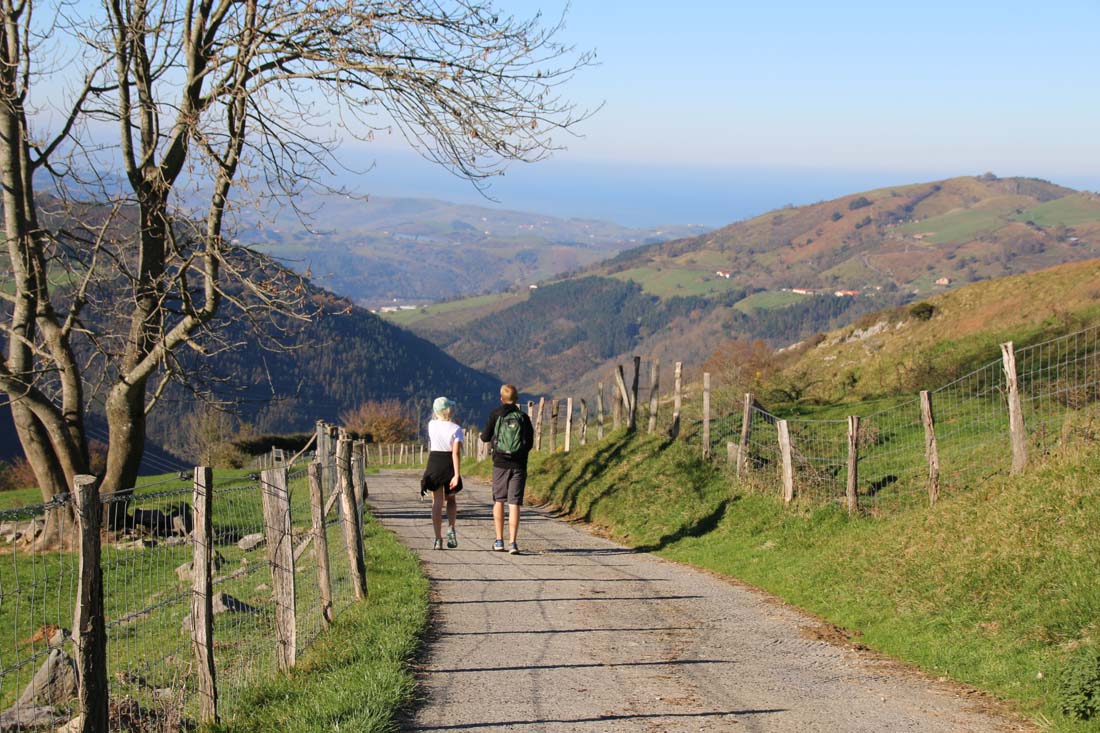 Adventuriety
Adventuriety
The day after the marathon in San Sebastian left us carless and forced me to navigate my half planned hike from our apartment to Pasaia, we set off on Scott’s originally determined and mostly well researched hike in Parque National Pagoeta on routes 4001 and 4002. We drove to Aia, a small village situated on the slopes of Mount Pagoeta in the Basque province of Gipuzkoa, Spain about 30 miles west of San Sebastián and began what Scott said was to be a long hike. 
It was a beautiful day, warm and sunny. We followed a narrow, paved road for about 1/2 mile until we reached the trail head.
Notice the yellow and white trail stripes and the red and white “X”…Spain has the best trail indicators so far in our hiking adventures.
The little village of Aia is already on the side of a mountain so with just a little walking you are rewarded with a great view. We could have just stopped right here, eaten our cheese and crackers and enjoyed the warm meadow.
But up the trail we went…
…the ocean and town receding into the distance with each step.
Trail check
The trail came out onto a road and the shadow of the mountain made for much chillier hiking.
It took only a short 45 minutes to make it to the top of a peak and back into the sunshine (notice the yellow and white trail marker on the post).
We found a large open meadow with an expansive view of mountains to the southwest.
The meadow was occupied by a herd of inquisitive, black horses grazing in the meadow. We saw lots of horses grazing in herds throughout Spain and growing up on a farm using horses, I wondered what these horses did for a living. In my research I learned that horses, though not all equal, are very important in the Spanish culture. These fellows are Pottoka horses, a semi-wild and ancient pony breed from possibly over 2,000 years ago. The ponies are a Basque icon and once common, their numbers have been severely diminished by habitat loss and cross breeding. Currently they are considered endangered and efforts are increasingly being made to protect these horses. The Pottoka was the first Basque horse breed to be included in the list of indigenous Basque breeds requiring conservation efforts in June 1995.
We found some mystery goop on top of a fence post.
We also found a summit cross and this was only one hour into our hike!
We continued on, the kids playing with a water bottle while hiking down a few steep and rocky parts of the trail.
Down off of the peak, we found some choices. Scott had shown us the trail map earlier and we had agreed to hike over the peak and then try and loop around the mountain back to Aia. Ashley had picked out some picnic tables on the map during our hike planning that she designated our lunch spot and one of these signs estimated another hour of hiking to our lunch break. Scott warned that this was our turn around point. We could retrace our steps or pull up our big boy hiking boots and gut out the rest of the hike.
We decided to continue on…but not this way!
We kept noticing these clumps of goo, first in the field of horses and on the fence post and now in the puddles along the road.
We walked down this storybook road wondering about the mysterious glop in the puddles.
A close up of the mystery slime. Scott later found out that these are eggs or frogspawn (seriously) from the Common Frog or Rana Temporaria found throughout Europe. Now how they ended up on top of the fence post is still a mystery!
I noticed a fossil of a sea shell in the rocks on the road.
The road became paved.
The kids entertained each other with a stick. We were getting hungry.
We found the picnic tables and enjoyed our cheese and crackers. The warmth of the day was waning, we had been hiking for about 3 hours and Scott estimated another 2-3 hours of hiking.
Back on the trail we met this curious creature that didn’t seem all that welcoming.
The clump of trees in the the left corner of this picture is where we had our cheese and cracker pit stop. It looked like a camping and picnicking area but it felt a little menacing. People lived in the church looking building and in the large building on the bottom right corner of the picture. It was walking by these buildings that we first observed the vicious Spanish guard dogs. There were two dogs chained to trees in a fenced yard that were barking and lunging at the end of their tethers as we walked by. I didn’t think much of it until most of the buildings we passed along this isolated stretch of road included a barking, growing dog or two chained to a doghouse or other structure near the entrance of the properties. I didn’t like the dogs lunging at us along the roads and there were two dogs that actually were not tied up and followed us with menacing looks and warning barks.I consulted Google and learned a few things. First of all, there is not a lot of specific information, mostly people on forums that are worried about dogs along El Camino del Santiago, the Way of St. James, but I did learn a few things. Many of these landowners actually prefer to live in the nearby villages and so the dogs are left to deter trespassers and protect livestock as they have done for hundreds of years. The consensus is that these dogs are often neglected and used merely as a utilitarian part of the landholding. One of the articles that I read talked about how in rural Spain especially, things are done as they have always been done and dogs are used as protection for property and livestock, not pets. There are people that are working to change this, but changing the old ways is proving difficult. It was an interesting contrast to the dogs that we observed in San Sebastian. There were many people that were out and about with their dogs on leashes, in strollers, playing on the beach and hiking the trails close to the city and in the first few rainy days we were there, I saw an astounding display of doggy raincoat fashion. The one dog without rain gear was being cradled like a baby and carried under an umbrella, so it was obvious to me that there are a lot of Spanish dog lovers. Scott made the observation that a place where people have pets indicates a high standard of living and that people have enough time and resources to enjoy a dog. The people in San Sebastian at least, seemed to dote on their dogs.
We climbed out of valley of semi abandoned buildings and guard dogs and steadily made our way up and up and up.
This hill was a one hour grind and while the boys hiked silently ahead, Ashley kept me company.
The gate at the top of the hill.
This meadow was in the middle of nowhere and we marveled, even after hours of hiking, at how perfect it looked.
We found another herd of horses, these fellows were friendly and wore bells and looked different from the small black Pattoka horses we had met earlier. I wondered about the significance of the bell wearing,pasture grazing herds of horses that we were seeing on our hikes. Since Roman times horses have been an important part of Spanish culture and there are many different breeds in the country, one of which is the Andalusian, also known as the pure and revered Spanish Horse. I’m not sure what breed these guys were, possibly a crossbred Pattoka or maybe the famous Andalusian. Regardless, a few of them came to the fence to visit.
We finally caught up to the boys…
…and continued our journey. At this point, the sun was getting low in the sky and apart from being very tired, I was happy. The workout had been great, the trail was flat and grassy, the vistas bucolic and I optimistically believed that this easy path would lead us back to the trail head and our car.
Still optimistic
The trail led through some crosses. Scott looked at the town far below and remarked,”The town is way down there.” The town was very tiny in the distance.
These crosses mark the end of the flat grassy trail and my optimism. It was nearly dusk and our goal lay far below us down a steep, leaf-slickened path. I didn’t take any pictures during the 45 minutes or so that it took us to descend through the dark forest. I was just concentrating on getting down the worst part before it was dark. I promised myself that flashlights would accompany us on the next hike, regardless of what time we started.
The forest disappeared and the trail leveled out with light to spare. by this time Ashley was carrying my backpack and camera.
The last little bit of the trail with the town of Aia in our sights.
We walked down the paved road into the town. The adventure had covered over 11 miles and almost seven hours. It was a good day and long day just as Scott had promised.






































